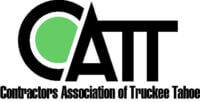REBATES – What You Should Know
Truckee Donner PUD Rebate Program
FINANCING – What You Should Know
With interest rates continuing to fall, many Truckee/Tahoe residents believe this is an ideal time to consider making home improvements that add value to their homes, enhance energy efficiency (going Green), or simply add more living space.
And since new residential construction is at a virtual standstill, it is also a good time to take advantage of the lull which can result in significantly lower construction costs.
Indeed, while on the surface these all appear to be good reasons to consider making a home improvement, there is one overriding consideration - how to finance a remodeling project.
Questions to Ask
Regardless of which CATT (Contractors Association of Truckee Tahoe) member you choose to use, you may need some financing. That means you are well advised to ask yourself some simple questions ...
- Will it increase the value of my home?
- How long will it take to complete the project?
- How much is it going to cost altogether?
- Do I need the money for anything beyond this particular set of home improvements?
Options for the Homeowner
Home Improvement Financing Options
There are several options when it comes to funding your home improvements – from cash to financing. The most common are home equity lines of credit, a home equity loan, personal unsecured loan, and cash-out refinancing of your current mortgage.
Let's go through each of these options in more detail, starting with cash.
Cash
You might already have the cash saved for your improvements. While this seems like the best option if you have it, keep in mind that by paying cash, you tie up money that could be earning interest, or working for you, elsewhere.
Personal Unsecured Loan
This type of loan is typically offered when there is no equity available and/or the financing need is under $10,000. Personal unsecured loans do not encumber your property and have little to no costs to obtain. The base qualifying factors are cash flow and credit.
Home Equity Line of Credit
A home equity line of credit is a revolving open ended line of credit. Secured by your home, these loans usually carry a variable interest rate based on the current Wall Street Journal Prime Rate. Costs are usually minimal and vary from lender to lender.
The line of credit is usually based on available equity in your home, taking a current appraised value and lending a maximum of 80% minus the balance of the 1st mortgage. Your creditworthiness and ability to pay will be considered when determining the amount of credit available to you.
A line of credit is a great way to finance home improvements as you are only paying interest on what you use of the available credit. Upon completion of your project/improvement and with your verbal request, many banks will offer to have that dollar amount rolled into fixed rate/term loan.
Home Equity Loan
If you aren't comfortable with the open-ended nature of a line of credit, a home equity loan may be right for you. This is a fixed-rate, fixed-term loan based on the equity in your home. The loan is paid back in equal monthly payments over a specified length of time and is often used for a single purpose such as new siding or major landscaping.
Home Improvement Loan
There are two special loans administered through the Federal Housing Administration (FHA) - Title I and Section 203(k) programs. A Title I loan allows you to borrow up to $25,000 for improvements to a single-family home. Loans must be made by an approved Title I lender.
The 203(k) program is not as well known, but if you are looking to purchase a fixer-upper, it's a terrific program. You can receive a single, long-term, fixed or adjustable rate loan that covers both the purchase and the rehabilitation of the property. You must use an FHA-approved lending institution.
Cash-Out Refinancing
If interest rates right now are at least one percentage point lower than your current mortgage rate, you might want to consider refinancing your entire mortgage. This alternative allows you to use the equity in your home to finance your improvements and include the improvements in your new lower-interest-rate loan. And you’ll have just one payment.
One or more of these home improvement financing options could work for you. Do your homework, and ask your trusted financial institution representative for assistance if the answer isn't clear.
Thanks to Shelly Wright with Plumas Bank for writing this article. You can email Shelly at Shelly.Wright@PlumasBank.com or call Shelly 530.587.4747 extension 1501
